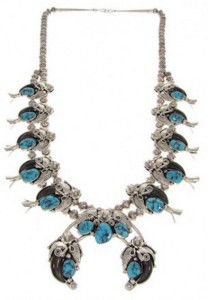
A Squash Blossom Necklace Is Historical Treasure, Artistic Delight
The beauty of a traditional Navajo squash blossom necklace cannot be denied; its artistic value and craftsmanship, usually of handworked silver, can vary from stylistically simple and modern to extremely large, ornate and bejeweled. A Native American squash blossom necklace may have intricate and symbolic etching, stamping and beading, or it may be relatively unadorned and simply polished.
Although the exact history of the squash blossom necklace is somewhat in dispute, there is no disagreement about the fact that the Spanish introduced metalwork, particularly silversmithing, to the tribes of the American Southwest. The squash blossom necklace, today, is almost synonymous with Navajo jewelry, just as “needlepoint” is associated with Zuni silversmiths.
Because of its availability, turquoise and sometimes coral, has been incorporated into the squash blossom necklace, but today’s artists are increasingly working with other stones and even other metals to create modern adaptations. Some of the most beautiful examples of the squash blossom necklace contain no stones, simply showcasing the artistry and skill of the silversmith.
A Squash Blossom Necklace Incorporates Traditional Forms
Almost always incorporating specific forms, including a central inverted crescent shape, surrounded by a beaded chain interspersed with “squash blossom” or “petaled” beads, a traditional squash blossom necklace was as likely to hang around a man’s neck as to be worn by women and girls.
It was originally used less for adornment perhaps than as a symbol of prestige, but the squash blossom necklace has retained a certain mystique that sets it apart and persists to this day. It is, indeed, one of the most sought after designs in “Old Pawn,” and a shiny, newly-crafted squash blossom necklace would delight many a modern woman as a particularly special gift.
Tracing the history of the central inverted crescent of the squash blossom necklace can be enlightening. Some historians insist that it is derived from a Moorish symbol transmitted to the Spanish. Indeed, horses that were ridden by Spanish conquerors sometimes were depicted with a type of squash blossom necklace hanging around their necks.
Other experts trace the lineage of the squash blossom necklace farther back in time, to the mists of prehistory, and note that the central pendant of a squash blossom necklace, known as a “Naja” by the Navajo, dates back to paleolithic times and can be found in numerous cultures.
Whatever its origin, however, a unique handcrafted squash blossom necklace is sure to delight to its owner.
